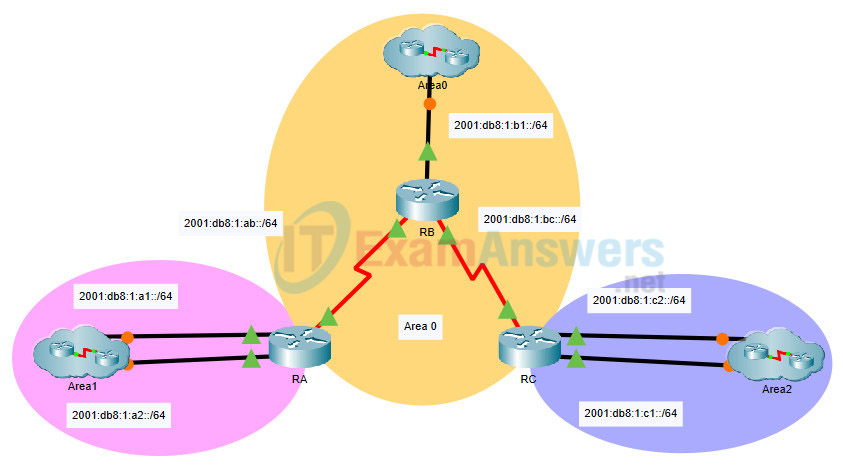10.2.1 Packet Tracer – Configure Multiarea OSPFv3 (Answers)
Topology

10.2.1 Packet Tracer – Configure Multiarea OSPFv3
Addressing Table
| Device | Interface | IPv6 Address | OSPF Area |
|---|---|---|---|
| RA | G0/0 | 2001:db8:1:a1::1/64 | 1 |
| G0/1 | 2001:db8:1:a2::1/64 | 1 | |
| S0/0/0 | 2001:db8:1:ab::2/64 | 0 | |
| Link-Local | fe80::a | N/A | |
| RB | G0/0 | 2001:db8:1:b1::1/64 | 0 |
| S0/0/0 | 2001:db8:1:ab::1/64 | 0 | |
| S0/0/1 | 2001:db8:1:bc::1/64 | 0 | |
| Link-Local | fe80::b | N/A | |
| RC | G0/0 | 2001:db8:1:c1::1/64 | 2 |
| G0/1 | 2001:db8:1:d2::1/64 | 2 | |
| S0/0/1 | 2001:db8:1:bc::2/64 | 0 | |
| Link-Local | fe80::c | N/A |
Objectives
- Part 1: Configure OSPFv3
- Part 2: Verify Multiarea OSPFv3 Operations
Background / Scenario
In this activity, you will configure multiarea OSPFv3. The network is already connected and interfaces are configured with IPv6 addressing. Your job is to enable multiarea OSPFv3, verify connectivity and examine the operation of multiarea OSPFv3.
Instructions
Part 1: Configure OSPFv3
Step 1: Enable IPv6 routing and configure OSPFv3 on RA.
a. Enable IPv6 routing.
RA(config)# ipv6 unicast-routing
b. Configure OSPFv3 on RA with a process ID of 1 and a router ID of 1.1.1.1.
RA(config)# ipv6 router ospf 1 RA(config-rtr)# router-id 1.1.1.1
Step 2: Advertise each directly connected network in OSPFv3 on RA.
Configure each active IPv6 interface with OSPFv3 assigning each to the area listed in the Addressing Table.
RA(config)# interface GigabitEthernet0/0 RA(config-if)# ipv6 ospf 1 area 1 RA(config-if)# interface GigabitEthernet0/1 RA(config-if)# ipv6 ospf 1 area 1 RA(config-if)# interface Serial 0/0/0 RA(config-if)# ipv6 ospf 1 area 0
Step 3: Configure OSPFv3 on RB and RC.
Repeat Steps 1 and 2 for RB and RC. The router ID for RB should be 2.2.2.2 and the router ID for RC should be 3.3.3.3.
RB(config)# ipv6 unicast-routing RB(config)# ipv6 router ospf 1 RB(config-rtr)# router-id 2.2.2.2 RB(config-rtr)# interface GigabitEthernet0/0 RB(config-if)# ipv6 ospf 1 area 0 RB(config-if)# interface Serial0/0/0 RB(config-if)# ipv6 ospf 1 area 0 RB(config-if)# interface Serial0/0/1 RB(config-if)# ipv6 ospf 1 area 0 RC(config)# ipv6 unicast-routing RC(config)# ipv6 router ospf 1 RC(config-rtr)# router-id 3.3.3.3 RC(config-rtr)# interface GigabitEthernet0/0 RC(config-if)# ipv6 ospf 1 area 2 RC(config-if)# interface GigabitEthernet0/1 RC(config-if)# ipv6 ospf 1 area 2 RC(config-if)# interface Serial 0/0/1 RC(config-if)# ipv6 ospf 1 area 0
Part 2: Verify Multiarea OSPFv3 Operations
Step 1: Verify connectivity to each of the OSPFv3 areas.
From RA, ping each of the remote devices in area 0 and area 2:
- 2001:db8:1:b1::2
- 2001:db8:1:a1::2
- 2001:db8:1:a2::2
- 2001:db8:1:c1::2
- 2001:db8:1:c2::2
Step 2: Use show commands to examine OSPFv3 operation.
Use the following commands to gather information about your OSPFv3 multiarea implementation.
show ipv6 ospf show ipv6 route show ipv6 ospf database show ipv6 ospf interface show ipv6 ospf neighbor
Note: Packet Tracer output for show ipv6 protocols is currently not aligned with IOS 15 output. Refer to the physical equipment labs for correct show command output.
Answer Scripts
Router RA
ipv6 unicast-routing ipv6 router ospf 1 router-id 1.1.1.1 interface GigabitEthernet 0/0 ipv6 ospf 1 area 1 interface GigabitEthernet 0/1 ipv6 ospf 1 area 1 interface Serial 0/0/0 ipv6 ospf 1 area 0
Router RB
ipv6 unicast-routing ipv6 router ospf 1 router-id 2.2.2.2 interface GigabitEthernet0/0 ipv6 ospf 1 area 0 interface Serial0/0/0 ipv6 ospf 1 area 0 interface Serial0/0/1 ipv6 ospf 1 area 0
Router RC
ipv6 unicast-routing ipv6 router ospf 1 router-id 3.3.3.3 interface GigabitEthernet 0/0 ipv6 ospf 1 area 2 interface GigabitEthernet 0/1 ipv6 ospf 1 area 2 interface Serial 0/0/1 ipv6 ospf 1 area 0
